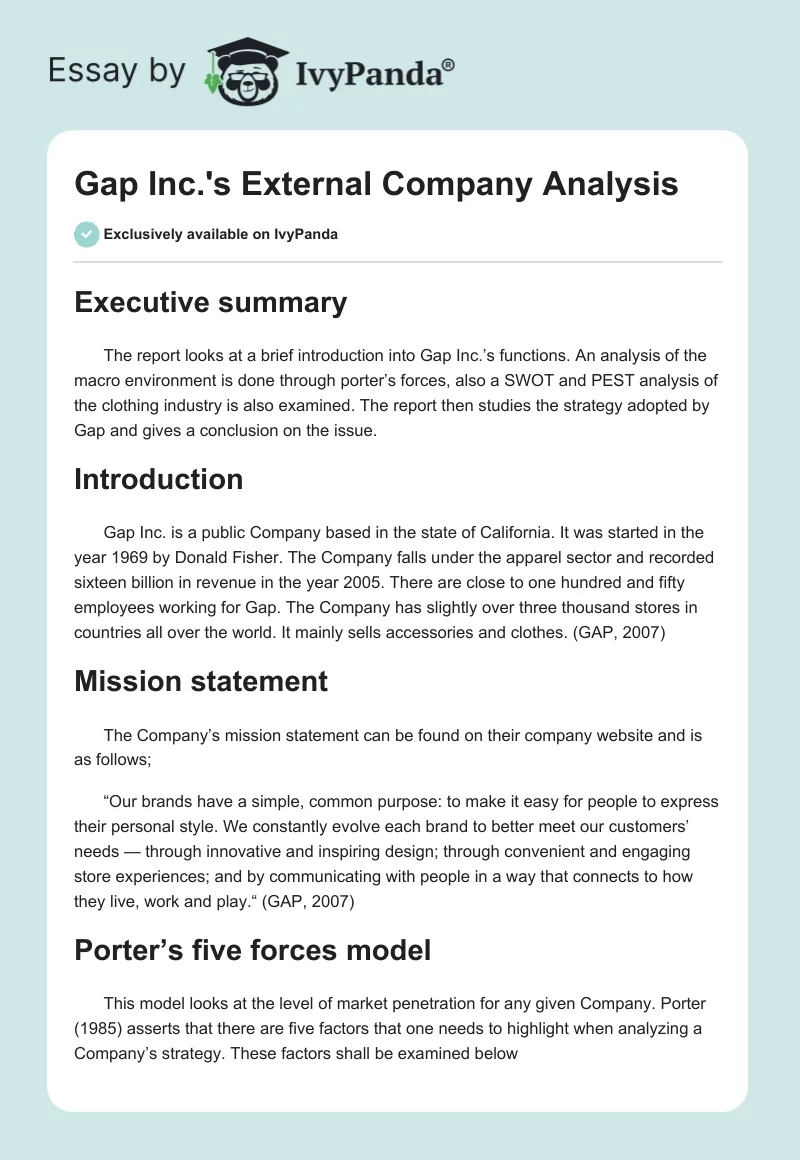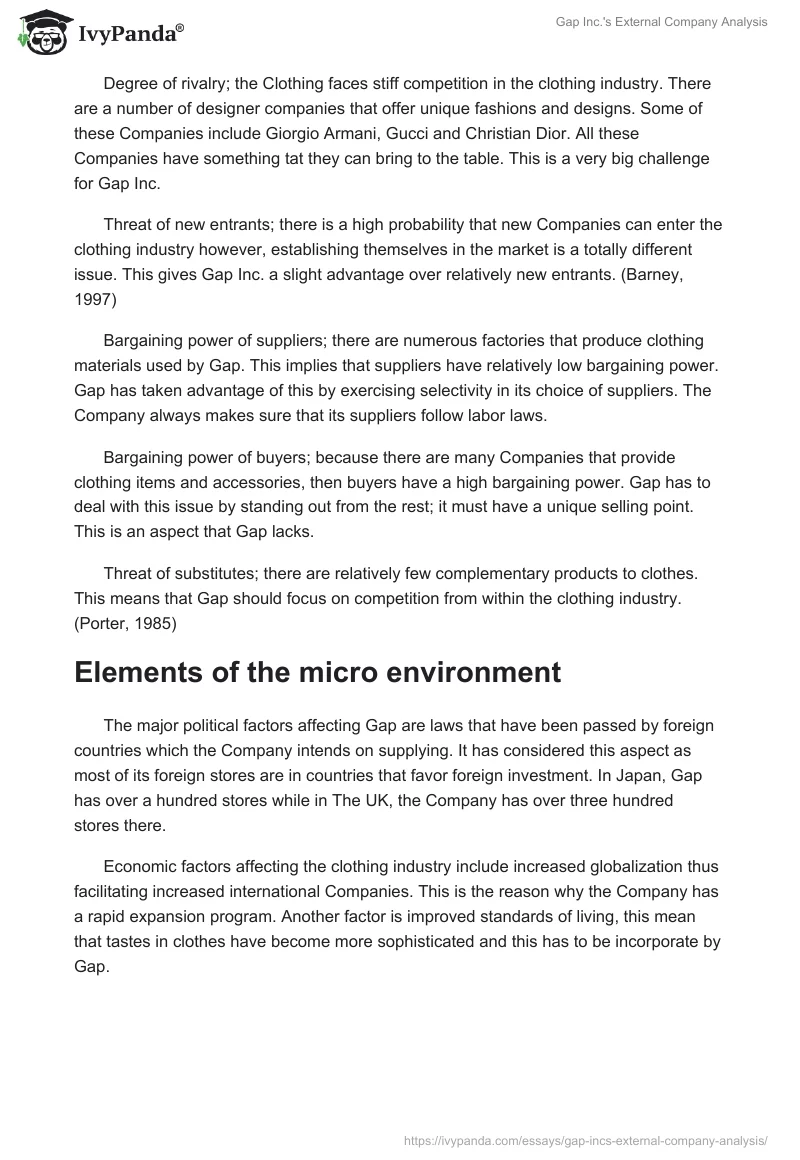Executive summary
The report looks at a brief introduction into Gap Inc.’s functions. An analysis of the macro environment is done through porter’s forces, also a SWOT and PEST analysis of the clothing industry is also examined. The report then studies the strategy adopted by Gap and gives a conclusion on the issue.
Introduction
Gap Inc. is a public Company based in the state of California. It was started in the year 1969 by Donald Fisher. The Company falls under the apparel sector and recorded sixteen billion in revenue in the year 2005. There are close to one hundred and fifty employees working for Gap. The Company has slightly over three thousand stores in countries all over the world. It mainly sells accessories and clothes. (GAP, 2007)
Mission statement
The Company’s mission statement can be found on their company website and is as follows;
“Our brands have a simple, common purpose: to make it easy for people to express their personal style. We constantly evolve each brand to better meet our customers’ needs — through innovative and inspiring design; through convenient and engaging store experiences; and by communicating with people in a way that connects to how they live, work and play.“ (GAP, 2007)
Porter’s five forces model
This model looks at the level of market penetration for any given Company. Porter (1985) asserts that there are five factors that one needs to highlight when analyzing a Company’s strategy. These factors shall be examined below
Degree of rivalry; the Clothing faces stiff competition in the clothing industry. There are a number of designer companies that offer unique fashions and designs. Some of these Companies include Giorgio Armani, Gucci and Christian Dior. All these Companies have something tat they can bring to the table. This is a very big challenge for Gap Inc.
Threat of new entrants; there is a high probability that new Companies can enter the clothing industry however, establishing themselves in the market is a totally different issue. This gives Gap Inc. a slight advantage over relatively new entrants. (Barney, 1997)
Bargaining power of suppliers; there are numerous factories that produce clothing materials used by Gap. This implies that suppliers have relatively low bargaining power. Gap has taken advantage of this by exercising selectivity in its choice of suppliers. The Company always makes sure that its suppliers follow labor laws.
Bargaining power of buyers; because there are many Companies that provide clothing items and accessories, then buyers have a high bargaining power. Gap has to deal with this issue by standing out from the rest; it must have a unique selling point. This is an aspect that Gap lacks.
Threat of substitutes; there are relatively few complementary products to clothes. This means that Gap should focus on competition from within the clothing industry. (Porter, 1985)
Elements of the micro environment
The major political factors affecting Gap are laws that have been passed by foreign countries which the Company intends on supplying. It has considered this aspect as most of its foreign stores are in countries that favor foreign investment. In Japan, Gap has over a hundred stores while in The UK, the Company has over three hundred stores there.
Economic factors affecting the clothing industry include increased globalization thus facilitating increased international Companies. This is the reason why the Company has a rapid expansion program. Another factor is improved standards of living, this mean that tastes in clothes have become more sophisticated and this has to be incorporate by Gap.
Threats and opportunities
Threats; Gap has been recording poor performance in its market. This can be attributed to the fact that the Company’s market strategy has been faulty. The Company has been engaging in haphazard expansions without focusing on quality of products. Consequently, the Company’s image has been distorted as people no longer know what Gap Inc. is all about. Also the Company lacks a unique selling point. Critics have accused the Company of offering uniform and bland items. Another threat that the Company is facing is the lack of a strong CEO. In 2007, Paul Pressler left and was replaced by the founder’s son Robert Fisher. The Company is still looking for a strong CEO to get Gap out of its current problems. All these issues pose a threat to the Company’s well being. (Barney, 1997)
Opportunities; the Company can choose a CEO that has experience and a unique understanding of the clothing industry thus changing market strategies in the Company. The Company can also improve its products by examining what is missing in the industry and then filling that gap. Besides this, the Company can also ensure that it establishes a strong brand identity. Customers should be able to identify Gap Inc’ with something peculiar. Lastly, the Company should offer competitive prices.
Market strategy adopted by the Company
The Company began a serious restructuring strategy under the leadership of former CEO Pressler. In my view, this was not the root cause of the problem as the restructuring scheme has not helped the Company at all. The cause of the problem was in the marketing mix used by the Company. This is what needs to addressed.
Conclusion
Gap Inc’ lacks a compelling product and an appealing service to offer the public. There is no need for a Company to expand to various countries in the world when products have not been reengineered or improved to suit those areas. If the Company applies a serious marketing mix, then it will be well on its way to regaining a strong market position. (UDEL, 2007)
Reference
Barney, J. B. (1997): Gaining and Sustaining Competitive Advantage. Reading, MA: Addison- Wesley.
GAP (2007). Web.
Porter, M.E. (1985): Competitive Advantage: The Free Press, New York.
UDEL (2007): Understanding consumer behavior. Web.


